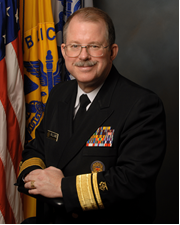

ROBERT C. WILLIAMS, P.E., DEE
THE TENTH CHIEF ENGINEER OF THE USPHS COMMISSIONED CORPS
CHIEF ENGINEER: 1999-2005
Robert C. Williams was born in Boise, Idaho in June 1954 and is known to his friends and colleagues as “Bob.” He earned a Bachelor’s degree in civil engineering in 1976 and a Master’s of Engineering degree in civil engineering with an emphasis in environmental engineering from Texas A&M University in 1979. He has continued his postgraduate education with courses in public health. In 1977, he married Karen Hassmann of New Braunfels, Texas.
He began his professional career in 1979 as an officer in the Army Medical Service Corps, serving at Fort McPherson, Georgia. He was a sanitary engineer with responsibilities across the southeastern United States, Puerto Rico, and Panama. His programmatic focus was water and wastewater facilities and toxic wastes. In 1984 he transferred to the PHS Commissioned Corps, beginning his PHS service as an environmental engineer in the Special Studies Branch of the Center for Environmental Health at CDC.
In 1985, upon the creation of the Agency for Toxic Substances and Disease Registry (ATSDR), Williams was assigned to the Office of Health Assessment as one of the forty charter employees of that agency. Two years later he was made chief of the Health Sciences Branch of the Office. In 1989 when ATSDR was reorganized with four operating Divisions, Williams was appointed Director of the Division of Health Assessment and Consultation. In this position, he directed a group of 170 personnel that performed public health assessments and health consultations/public health advisories on hazardous waste sites across the nation with a particular focus on the designated superfund sites.
In June of 1999 while retaining his ATSDR responsibilities, he was appointed to the position of Chief Engineer of the PHS with the title of Assistant Surgeon General and the rank of Rear Admiral (RADM) in the Commissioned Corps. During his tenure as Chief Engineer he provided advice and consultation on public health engineering matters to the Surgeon General and to over 1200 engineers and architects in the USPHS. He represented the Surgeon General on numerous occasions with public and professional organizations. Among his many accomplishments RADM Williams: Developed the White Paper: Chief Professional Officer’s Roles and Responsibilities; Co-developed the White Paper: Recruitment and Retention; Wrote the Critical Review of Ready Reserve Report; Co-Chaired the Commissioned Corps Promotion Task Force; provided oversight to the Surgeon General’s Workshop on Healthy Indoor Environment; Transitioned the USPHS into the Society of American Military Engineers (SAME) as a Service Organization; Represented the USPHS as Service Chief to SAME; Created the inaugural Engineer’s Challenge Coin; Established the John Villforth Leadership Award and the SAME-USPHS Awards; Provided Oversight of the Healthy Building Initiative and the Engineer’s Emergency Response Guidance; Established the inaugural Engineer and Architect Leadership Development Seminar Series: Established the USPHS and Schools of Engineering Association; Served as the General Chair, COA Annual Health Professionals Conference in Atlanta; and, gave presentations to USPHS Engineers and Architects in 20 states across the Nation.
In 2004, RADM Williams was appointed Chief of Staff of the Office of the Surgeon General while still serving as Chief Engineer. In that new role he assumed the additional duties as Chief Operations Officer of the Commissioned Corps with responsibilities for the direction and management of the office of the Surgeon General, which included the areas of Science and Communications, Force Readiness and Deployment, Reserve Affairs, Commissioned Corps Operations, and Military Liaison and Veterans Affairs. In 2005, after six years as chief engineer he completed his service and subsequently served in roles of increasing responsibility within the Office of the Surgeon General. In October 2007, he was appointed as the Acting Deputy Surgeon General.
As Acting Deputy Surgeon General, he was the principal assistant and advisor to the Surgeon General regarding the development and implementation of programs, priorities, and initiatives for the Office of the Surgeon General. As Deputy Surgeon General, RADM Williams maintained effective relationships and collaborations with executive leadership within the federal government and served as Chief Executive Officer of the 6,500-plus members of the USPHS Commissioned Corps.
RADM Williams has more than 45 years of experience in environmental engineering and public health. He is a Registered Professional Engineer and serves, or has served, as an officer and member of national committees for several professional organizations including: American Water Works Association, Water Environment Federation, American Society of Civil Engineers (ASCE Fellow Grade), Society of American Military Engineers (SAME Fellow), AMSUS, and the Commissioned Officers Association of the US Public Health Service. He was an Adjunct Associate Professor at the Texas A&M University School of Public Health and served as a member of the Emory University Academic Advisory Council, responsible for developing the University's environmental health curriculum. He has authored and presented more than 100 publications on a wide variety of environmental health issues, including the co-editing of four books.
RADM Williams is the recipient of two USPHS Distinguished Service Medals, Meritorious Service Medal, two Surgeon General’s Medallions, four Surgeon General’s Exemplary Service Medals, the Outstanding Service Medal, three Commendation Medals, an Achievement Medal and 15 Outstanding Unit and Unit Commendation Medals. He received the COA Robert Brutsche Award in 2015 and the ASCE President’s Award in 2012. He received the Stanley E. Kappe Award from AAEES in 2004. He received the Gorgas Medal and the first Lifetime Achievement Award from AMSUS and the ASCE Government Engineer of the Year in 2003. He received the CFEE Federal Environmental Engineer of the Year, PHS Engineer of the Year, and NSPE Top Ten Federal Engineer Awards. He received several group awards including five DHHS Secretary’s Distinguished Service Awards, SAME Cumming Plaque, ATSDR/CDC Honor Awards for Public Health Practice, and several professional society awards.
He currently is a private consultant on public health and environmental engineering matters providing advice to federal, state and local governments. He and his wife, Karen, live in Schertz, Texas.
10/2018
Back to History of USPHS Engineers